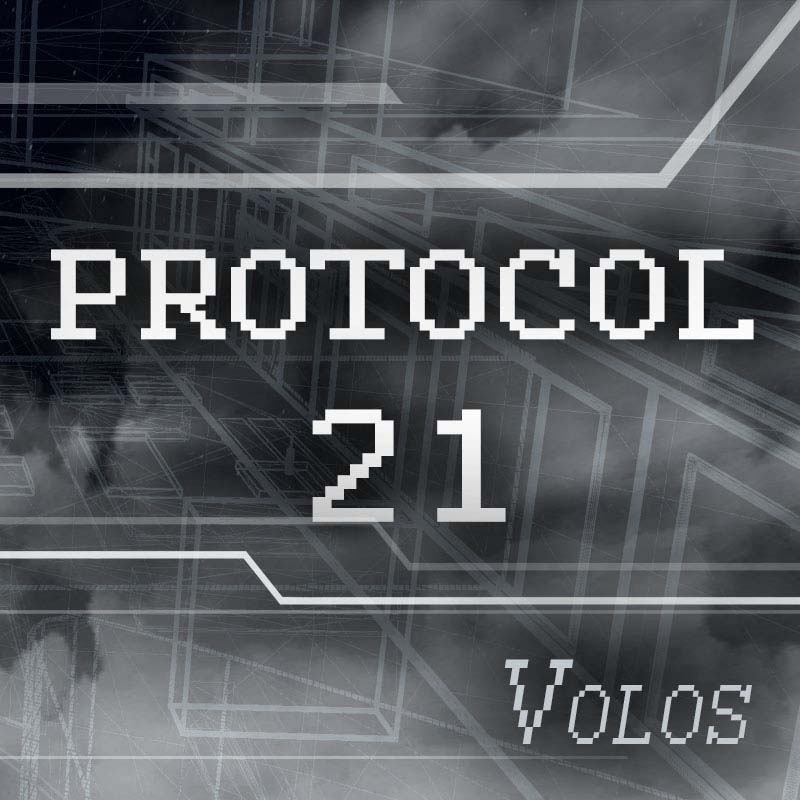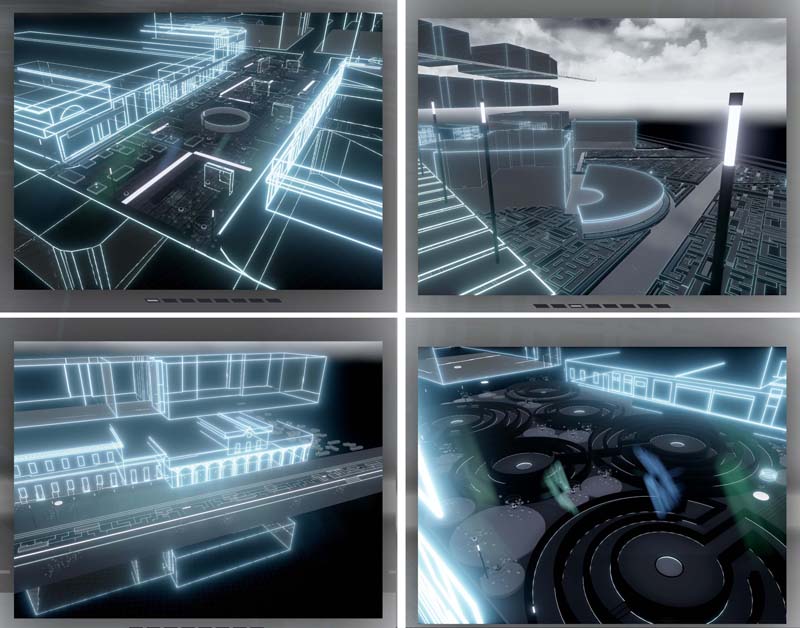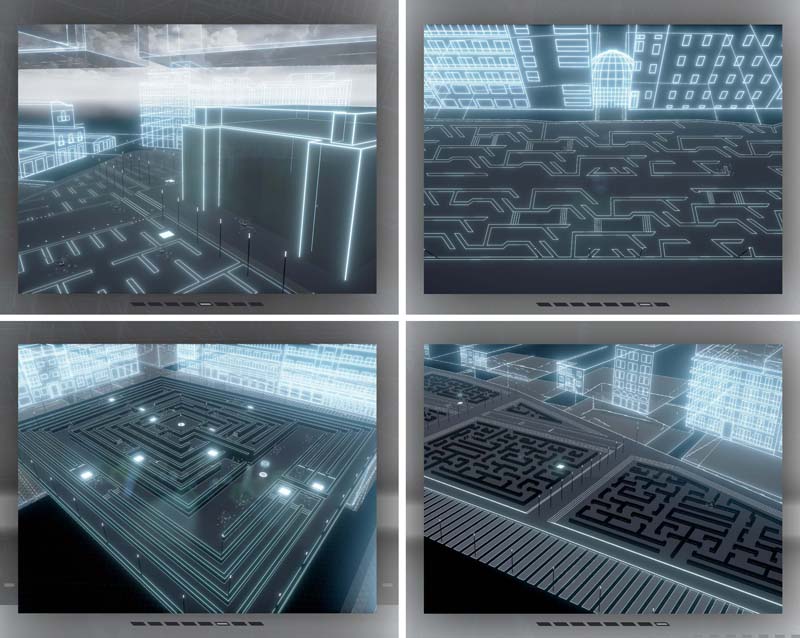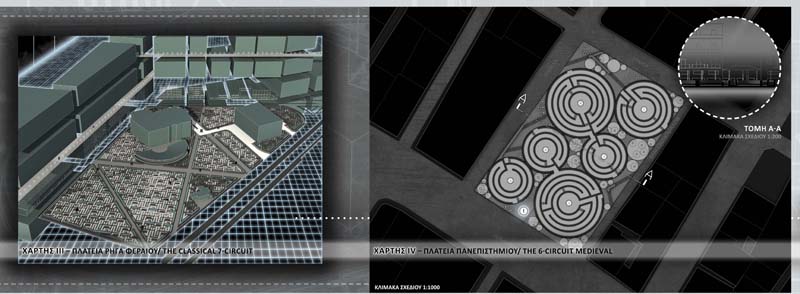

In modern cities, public play areas are of great importance since, there, the kids become active through contact with other children.
Unfortunately, the current approach to shaping these areas fails to attract and strengthen its position in the city. The equipment is standard and also directs the movements of the user.
At the same time, the pressures of young people to cope with today's demands, more and more stifle their unconstrained spontaneity.
The aim of this dissertation is to redefine the position of children in the city through a different design approach of public space. This area will be addressed both in children and in older ages. When children are not there, the site will be accepted by all as something familiar and not as a dead zone.
In the area chosen, apart from open configuration, two buildings are put, devoted to artistic activities (painting, construction etc) and will be open to young people throughout the day. The courses, workshops etc will be held but when you do not have any of these, the place will be open to young people to get involved and create something that interests them. This way spaces will be created with additional features that will appeal to them.
Supervisor: Trova Vasso
Reference Number: 573


This thesis is attempting to shed light on the possibility of a radical alternative about inhabitance and production of the city. It is articulating thoughts and gestures-in the middle of the economic crisis- using as materials the piles of failure, “the creative destruction” of bodies, the hills of objects, and of various kinds of products, which cultural capitalism is broadly producing for consumption. In the desert of isolation, unfulfilled expectations and biopolitical authority, we are groping way outs for our desires and needs. On a way of active reflexion we are using the theoretical contribution of Walter Benjamin, we are ‘talking with’ Slavoi Zizek and we are sharing analytical forms with Giorgio Agamben. “We are embracing catastrophe”, pinpointing the contradictions and the no-way outs of capital development and through the parts without share, we are attempting proceedings of redefinition of the whole out of the remainder. We are studying the centre of Volos, we are observing the neighborhoods of abandonment, the signs of crisis in the “building’s reserve” of the city. We are suggesting the reactivation of the buildings in idleness via a biased Archaeology which is touching upon the craftsman and at the same time is gazing the future of the common things. We are bringing the remainders of civilization on the scene, we are reconstructing them as objects of use value, residential equipment of the new city. We are getting organically connected to the street as a front line in the struggle for the “right to the city”. We are occupying time in the present, so as the collective way, to puncture the repeated cycle of the no- alternative.
- commucopia is the section we are opening in order to traverse the fantasy. It is a network-workshop which is declaring the state of emergency, seeking radical justice.
Supervisor: Kotionis Zissis
Reference Number: 612


This thesis experiments with the denotation of the hole, both in theoretical and practical level. Initially, the “Hole Atlas”, which is created by an archive and diagrams, is used as a tool that urges on the creation of a “re-drilling”. It produces a dialogue through multiple readings, creating a narrative path which is branching and is continually divided, that converts it in a constantly evolving state.
The Atlas operates as the dominant inquiry, demonstrating the multiplicity of thematic hole and seeks to produce a series of relationships, taking advantage of its extensive materiality of the topic. It goes after proving how the perforation of the material and the observation of the emptiness and the discontinuity, are equally relevant to architecture, literature, art, philosophy, psychoanalysis and body searches.
Through the research of the hole and the performance of "holing" we are trying to doubt the methodology of architecture as an addition and define it in terms of abstraction, complexity, ambiguity and void. From the subconscious to the underground sanctuary, a familiarized attempt is produced, through impulses, wanderings, disturbances and disasters which penetrates in realms such as the body, the natural and urban landscape. We analyze the meaning of the hole as a separate entity and a topological model that wanders between surface and depth, inside and outside. Thus, a route is made: through foundations, walls, soils, grounds, digital structures and materials, with strong interaction to external challenges, which is often being dissolved, but also dissolves the existing relationships.
Supervisors: Kotionis Zissis, Tzirtzilakis Yorgos
Reference Number: 589


The main principal of this thesis is the inclusion of the elderly on the wider social context. The elderly form a very important demographic, that often have to deal with financial problems and in certain cases even struggle with covering the basic needs. In this thesis there is a proposal focusing on people over the age of 60, that however don't require medical assistance and are self-reliant. A society that respects every age group, is a society that respects every person separately, every existence. For the elderly, the ideal environment is one that provides them with independence and, at the same time, coexisting with other age groups. The suitable design of such an environment, as well as, the location of their residences near places and facilities that contribute to their social inclusion, can play a great role in offering to the elderly a pleasant experience. The structure of the building lot is mainly influenced of the surrounding building lots, in conjunction with the desire of creating a neighborhood that consists of areas giving to the tenants the opportunity of interaction and direct contact with their neighbors.
Specifically, our proposal includes 7 duplex apartments 100m2 , together with facilities that can keep the elderly busy in their spare time and make them feel active . Lecture halls, projection rooms, a kitchen that everyone can use in order to collectively cook meals, a small hotel for the housing complex's visitors, and a hydrotherapy center with a pool and massage rooms complete the complex. Last but not least, is the importance of the exterior as apart from the green spaces, there is also a cultivated area that the elderly themselves can take care of. In addition to this, there is a store selling these crops, crafts like knitted clothes as well as viands and sweets that the tenants have produced.
Supervisor: Stylidis Iordanis
Reference Number: 572


In this thesis is studied the creation and the adaptation of a Formula 1 Grand Prix inside the urban tissue (such as the example of Monaco) and more specifically if that can be integrated into the city of Volos.
The study begins with references to existing Grand Prix worldwide and then categorized the data and the requirements that are necessary in order to generate such an event. Although it is essential that these rules do not become an end in itself and the primary design tool, since the primary object of the study is to design such a heavy use in conjunction with the minimum interference in the urban fabric. So they are proposed specific sites for construction - to create the necessary structures and services for this organization, but also other areas where the interventions are softer so as to improve the daily and quality of life of the citizens.
Furthermore these interventions are studied on a smaller scale and in greater detail. Analyzed design of the necessary buildings and the basic equipment, comes next, always according to the strict rules and regulations of the FIA (Federation International de l Aytomobile). Also they are proposed urban furniture equipment such as benches, lighting, moving beds etc, with the dual purpose of forming the new urban landscape and servicing of the event during the four days of the race.
Summarizing this study a key question for reflection is raised: If it is really possible and true such an international organization of motor sport to help the financial problems of a state, like Greece, due to the luxury tourism, the showcasing of the host country to millions of viewers and its requires of a large number of seasonal workforce, the months before the Grand Prix, for the preparation of the event.
Supervisor: Trova Vasso
Reference Number: 605


There are two ways to climb a mountain. On the one hand the helical paths aimed at a smoother touring experience in nature. On the other, linear, steep paths using the subject for a more experiential, intense experience through hiking. This subject does not seek comfort but a more rugged and tedious routes, which can create sensations during ascent before the final goal.Putting these two condition to use the hill of Lycabettus is changed to a hybrid landscape of contradictions attached within the urban fabric. Artificial linear paths contradict to the polymorphic tour of natural pathways, but also create a connection with the Athenian cityscape. The specific orientation of the linear path gives a visual equivalent to the filmic, which because of its economy shrinks the landscape and changes it to an intermediate element that connects two or more points. The gradual distancing or approach from and to the landmarks, produces a constant zoom in and zoom out capable of creating an interesting visual experience. Theuser trying to "conquer the peak" and the ultimate view of the Athenian city, follows these four straight paths that pass throughLycabettus and are strengthened through the uses of stops that are interposed. Four different routes, four different points of interest in the city, four different experiences that are joined at the peak on a square:
1. The steep - sunken stairway turns his eyes towards the hill of Strefi
2. The mechanical - hangingroute facing the Acropolis
3. The local path of the water ends up in the square Deksameni, facing the Temple of Olympian Zeusand the Saronikos bay
4. The smooth path extending to the modern city
Supervisors: Paniyiris Costis, Papadopoulos Lois
Reference Number: 575












This diploma project was produced in order to interpret the most important points of Volos city and to transfer them to the digital world, so that users can interact with the new intangible environment.
First of all, the background of the user’s interaction is presented. The environment in which they move constitutes a future version of the city and the user handles an artificial entity, which is tracking human life. The user’s purpose is to find the transferring circles in each and every interactive map, in order to reach the last map, where the game is finished. Every section in this environment includes geometric and functional features that affect the user’s experience there. Maze walls, points of interest, portals and moving stairs are some of the architectural elements that every map consists of, while movable or fixed threats that are found in the environment allow or prevent motion.
In the second chapter we find the whole amount of maps that were used. Every map features its own chapter of description, which includes information about each square’s design, the pattern that was used and the reason for that selection, based on historic, etymological or geometric features. Later on, the surroundings’ facades were transferred to the digital world, which was achieved with the photographs that were taken in site. The chosen pattern, the section of the redesigned square, the general renders and the floor plan of each square are the ones that fully present the result in the three dimensional space, so that it can be totally understood by the user. Unreal Engine contributed with the ability it provides the user to interact with the produced environment and with the high quality screenshots that were taken.
In the end, an analysis similar to the research subject “Pneuma: Breath of Life, first person perspective and simulation of architectural experience through videogames” is written down. The visual perception of the user, the motion through space, their free or restricted flow in this new environment and the open air rooms that they find are the basic features of their experience. Apart from these, the dipole between light and dark, the materials and the details of these squares, the atmosphere of the environment and the user themselves participate in the experience as well, creating the general sense in the end of the game.
Supervisor: Papadopoulos Spiros
Reference Number: 608


